Managing Acne: Your Comprehensive Guide to Clearer Skin
Struggling with acne can feel incredibly isolating, but you’re definitely not alone. Acne is a common skin condition that happens when hair follicles get clogged with oil and dead skin cells, affecting people of all ages. It can be incredibly frustrating to deal with, whether you're facing just a few pimples or more severe breakouts.
In this blog, we’re here to support you with everything you need to know about acne. We'll explore the different types and causes, share effective home remedies, and guide you on when to seek professional help. Let’s work together to get your skin back on track!
BM38 provides natural support for inflammation of the skin's hair follicles and sebaceous glands; acne vulgaris, topical acne, infantile acne, chemical acne, or acne due to increased levels of androgen hormones.
What are the symptoms of acne?
Acne can appear anywhere on your body, but it's most common on your face, neck, shoulders, back, and chest. If you have acne, you'll notice blackheads and whiteheads. Blackheads are open at the surface of your skin and look black because the gunk inside reacts with the air. Whiteheads, on the other hand, are closed just under your skin, so they appear white.
Besides these, other types of acne can be more severe. Nodules are firm, painful lumps that form deep under your skin. Pustules are small, red pimples with a pus-filled tip. Papules are tiny, red, raised bumps caused by inflamed or infected hair follicles. Cysts are large, painful lumps under the skin that are filled with pus.
While blackheads and whiteheads are the most common types of acne, other types can be more severe and might lead to scarring if not treated properly.
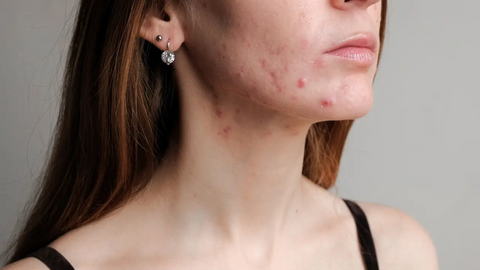
What causes acne?
Acne happens when your skin’s pores get clogged, usually by oil, dead skin cells, and sometimes hair. Under your skin, sebaceous glands produce an oily substance called sebum, which helps carry dead skin cells to the surface. When everything works fine, a small hair grows out of the pore. But when the follicles (tiny sacs connecting the glands to the pores) get blocked, oil builds up underneath, leading to pimples.
This sebum, skin cells, and hair plug can become infected with bacteria, causing swelling and eventually forming a pimple. The bacteria most often involved is called Propionibacterium acnes (P. acnes). Not all strains of this bacteria cause pimples; some help keep your skin clear.
Hormonal Factors
Hormones, especially androgens, play a significant role in acne. Androgens are hormones that increase during puberty, causing the oil glands under your skin to grow and produce more sebum. This excess oil can break down cell walls in the pores, making it easier for bacteria to grow. In women, androgens get converted into estrogen.
Kali Sulph is best used for eruptions on the skin and scalp problems, especially when there is yellow pus. It may help carry oxygen to your cells and benefit respiration. Useful when you feel stuffed up or have a cough with yellow phlegm & more.
Other Possible Triggers
Other factors might trigger acne, including genetics and hormonal changes. Some common triggers are:
- Menstruation
- Emotional stress
- Hormonal changes
- Medications containing androgen and lithium
- Greasy cosmetics
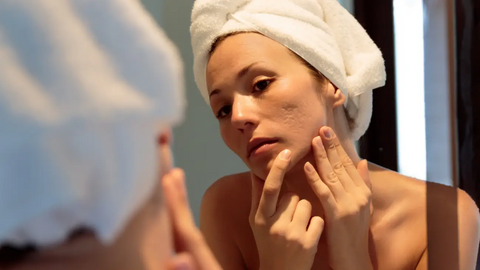
Risk factors
Certain things can increase your risk of developing acne. Although there's no solid proof that foods like chocolate or fries cause acne, some factors do make it more likely:
- Hormonal changes during pregnancy or puberty
- Specific medications like certain birth control pills or corticosteroids
- A diet high in refined sugars or carbs, like bread and chips
- Having parents who had acne
The highest risk of developing acne is during puberty because your body experiences significant hormonal changes, which increase oil production and the likelihood of clogged pores. This type of hormonal acne usually gets better as you move into adulthood.
Types of acne
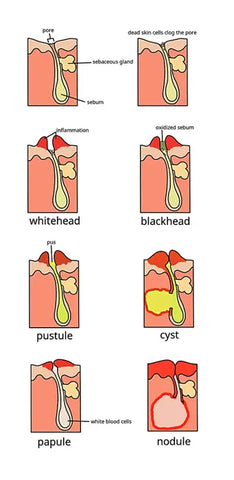
Acne isn't just one thing; it comes in different shapes and sizes. Here's a rundown of the various types you might encounter:
- Blackheads: These are tiny, dark spots on your skin. They form when a pore gets clogged with oil and dead skin cells. The surface stays open, so it looks black due to the reaction with air.
- Whiteheads: These are similar to blackheads, but the pore is closed off, so they appear white or flesh-colored. They also form when oil and dead skin cells clog a pore but stay under the surface.

- Papules: These are small, red, raised bumps that occur when the walls surrounding your pores break down from inflammation. They can be tender to the touch.
- Pustules: Most people think of pustules as "zits." They're red, inflamed bumps filled with pus from a combination of oil, dead skin cells, and bacteria.
- Nodules: These are large, solid, painful lumps that form deep within the skin. They result from severe inflammation and can be pretty uncomfortable. Nodules don’t usually have a "head" like pustules.
- Cysts: These are even deeper and more painful than nodules. They're large, pus-filled lumps that form beneath the skin's surface. Cysts can lead to scarring if not treated properly.
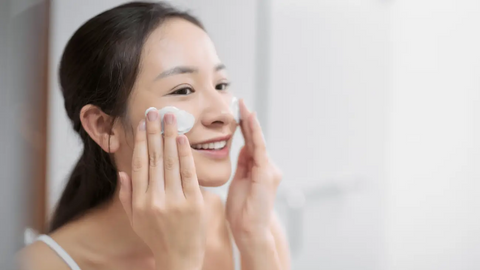
Tips for preventing and treating acne
Here are some simple tips to help manage and prevent acne:
- Wash your face gently: Clean your face no more than twice a day with warm water and a mild soap designed for acne. Refrain from scrubbing too hard.
- Hands off: Avoid touching your face, and don't squeeze or pick at pimples. Doing so can push the infection deeper, worsening with more swelling and redness.
- Clean hands: Wash your hands regularly, especially before applying lotions, creams, or makeup.
- Remove makeup: Always take off your makeup before going to bed.
- Choose the right products: Use makeup and skincare products for sensitive skin and avoid oil-based products.
- Don’t pop pimples: Popping can lead to scarring. See a specialist if you have a pimple that needs to be removed for cosmetic reasons.
- Keep your phone and glasses clean: Phones and glasses collect oil and skin debris, so wipe them down regularly.
- Wear loose clothing: If you have acne on your back, shoulders, or chest, use loose clothing to let your skin breathe. Avoid tight accessories like headbands, hats, and scarves unless you wash them often.
- Shave carefully: Use an electric or sharp safety razor when shaving. Before applying shaving cream, soften your skin and beard with warm, soapy water.
- Keep your hair clean: Sebum and skin debris can collect in your hair, so wash it regularly. Avoid greasy hair products, especially those with cocoa butter.
- Be sun-smart: Some acne medications can make you more prone to sunburn. Too much sun can also cause your skin to produce more oil, so protect your skin from excessive sun exposure.
- Manage stress: Stress and anxiety can boost cortisol and adrenaline levels, worsening acne.
- Stay cool and dry: In hot and humid climates, try to stay cool and dry to prevent sweating, which can aggravate acne.
These tips can help you keep your skin clear and manage acne effectively. Consider seeing a dermatologist for specialized treatment if your acne is severe or persistent.
BM38 provides natural support for inflammation of the skin's hair follicles and sebaceous glands; acne vulgaris, topical acne, infantile acne, chemical acne, or acne due to increased levels of androgen hormones.
Why You Should Prioritize Natural Remedies for Acne
Natural remedies for acne can be an excellent option for several reasons. First, they're generally gentler on your skin than many chemical treatments. Harsh chemicals can sometimes cause irritation and dryness or even worsen acne. Natural ingredients like tea tree oil, honey, and aloe vera often have soothing properties that help reduce inflammation and fight bacteria without the harsh side effects.
Another reason to go natural is that these remedies are usually more affordable and accessible. You already have some in your kitchen or can easily find them at your local grocery store. Plus, using natural ingredients means you know exactly what you're putting on your skin—no mystery chemicals.
Lastly, many natural remedies have been used for centuries and have a long history of success. While they might not work for everyone, they're worth a try before moving on to more potent, potentially more harmful treatments. Always remember, though, if your acne is severe or persistent, it's a good idea to see a dermatologist for professional advice.

Home Remedies for Acne
Here's a breakdown of a few popular home remedies that might help:
Apple Cider Vinegar
Apple cider vinegar has organic acids like citric acid, which can kill the bacteria that cause acne. It also has succinic acid, which reduces inflammation and prevents scarring, and lactic acid, which can improve the appearance of scars. Be careful, though, as it can cause burning and irritation. Always dilute it with water and use it sparingly.
Zinc Supplements
People with acne often have lower levels of zinc in their blood. Taking zinc supplements can help reduce acne, but don’t overdo it—too much zinc can cause stomach pain and irritation. Applying zinc directly to the skin isn’t very effective since it doesn’t absorb well.

Honey and Cinnamon Mask
Honey and cinnamon are great for fighting bacteria and reducing inflammation. A study found that honey and cinnamon together have antibacterial effects against acne-causing bacteria. Even honey alone can help, but it's not a guaranteed acne cure.
Tea Tree Oil
Tea tree oil, derived from an Australian tree, is known for its antibacterial and anti-inflammatory properties. Studies show it can reduce acne and cause less skin irritation than traditional treatments like benzoyl peroxide. Apply it directly to the skin, but always dilute it with a carrier oil.
Green Tea
Green tea is good for your health; applying it to your skin can help acne. The antioxidants in green tea can fight bacteria and reduce inflammation. While there's limited research, it's a promising natural remedy.
Witch Hazel
Witch hazel, derived from the bark and leaves of the witch hazel shrub, has strong antibacterial and anti-inflammatory properties. It's used for various skin issues, such as dandruff, eczema, and acne. However, more research is needed specifically on its effectiveness for acne.
Aloe Vera
Aloe vera is famous for soothing burns and skin conditions. The gel from its leaves contains salicylic acid and sulfur, commonly used to treat acne. Aloe vera can also help heal injuries, treat burns, and reduce inflammation.

Sulphur is useful for skin problems, hot flashes, pimples, and skin eruptions with scratching and burning sensation.
Fish Oil Supplements
Fish oil is rich in omega-3 fatty acids, which have numerous health benefits, including reducing inflammation. High levels of omega-3s can help lower the risk of acne. Many people don’t get enough omega-3s in their diet, so supplements can be helpful.
Exfoliate Regularly
Exfoliation removes dead skin cells that can clog pores. You can use chemical exfoliants like salicylic or glycolic acid or physical exfoliants like scrubs. Be gentle, as harsh scrubs can irritate and damage the skin. Exfoliation can make acne treatments more effective by allowing them to penetrate deeper.
Eat a Low Glycemic Diet
Diet can impact acne, especially foods with a high glycemic index (GI), which causes blood sugar levels to spike. High-GI foods can increase sebum production, worsening acne. Avoid processed foods like white bread, sugary drinks, and pastries. Opt for low-GI foods like fruits, vegetables, legumes, nuts, and whole grains.
Avoid Dairy Products
Dairy products contain hormones that may trigger acne. The link is still debated, but hormones in milk can cause hormonal changes leading to acne.
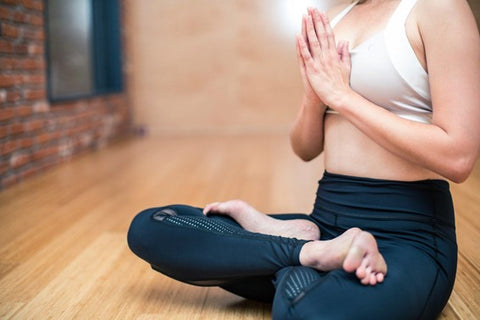
Reduce Stress
Stress can worsen acne by increasing sebum production and inflammation. It also affects gut bacteria and can delay the healing of acne lesions. Reduce stress by sleeping more, exercising, meditating, and practicing yoga.
BIO16 is recommended for nervous exhaustion, fatigue, or sleeplessness resulting from stress and anxiety. Natural support for your nervous system to help cope with everyday stress and negative events.
Exercise Regularly
Exercise boosts blood circulation, which nourishes skin cells and helps prevent and heal acne. It also helps regulate hormones and reduce stress, which can improve acne.
Homeopathy
Homeopathic treatments have been shown to be effective for severe acne. Some studies show a high remission rate with individualized homeopathic remedies, with long-lasting effects and minimal side effects.
Trying out these home remedies can be a natural way to manage acne. Still, results can vary from person to person.
BIO20 supports healthy cell regeneration and promotes the skin's youth, radiance, and healthy appearance. This combination of cell salts is useful for eczema, psoriasis, acne, pemphigus, and dandruff. It is also useful for visible scars, cradle caps, and neonatal dermatitis.
When to See a Doctor
If your acne isn't clearing up with home remedies, it's time to see your family doctor. They might prescribe stronger medications to help. If your acne is persistent or severe, you should see a dermatologist or a pediatric dermatologist for specialized treatment.
For many women, acne can stick around for decades, often flaring up a week before their period. For those using contraceptives, this type of acne usually goes away without any extra treatment.
If severe acne suddenly appears in older adults, it could signal an underlying condition that needs medical attention.
BM7 may help with inflammation, skin allergy, Eczema, Dermatitis, Pimples, Acne, Warts, Psoriasis, Urticaria, and many other skin ailments.
The Bottom Line
Dealing with acne can be quite challenging and create insecurities, but many ways exist to manage and treat it. From simple home remedies like apple cider vinegar and tea tree oil to more specialized treatments from your doctor, there's hope for clearer skin.
Everyone's skin is different, so what works for one person might not work for another. Be patient, try different approaches, and don't hesitate to seek professional advice if needed!


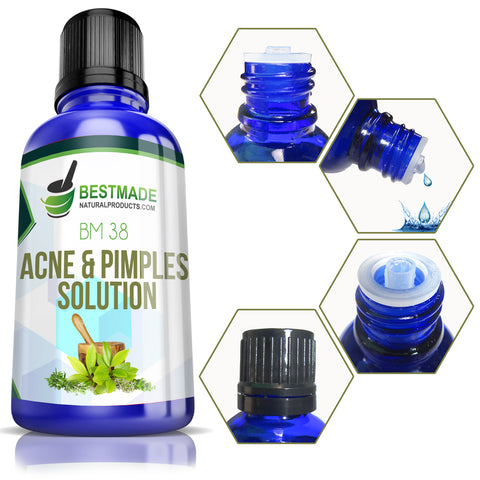

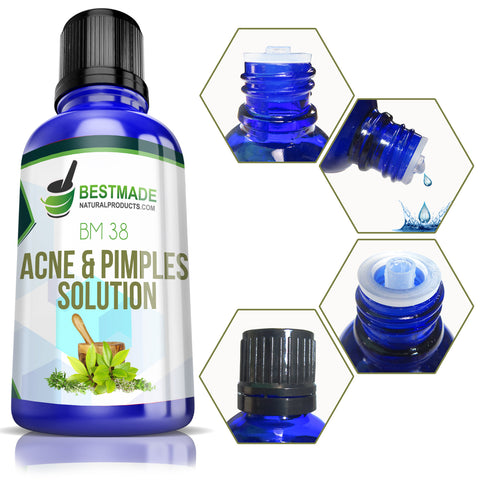
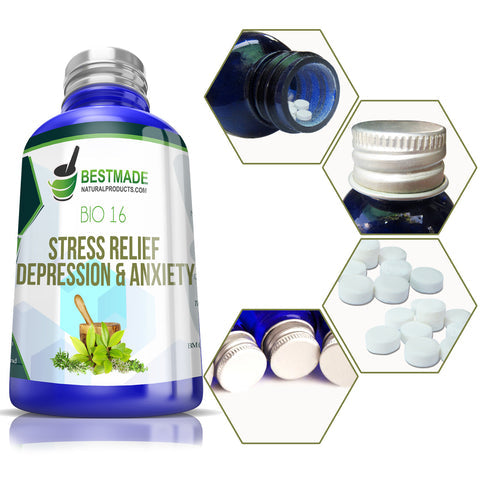
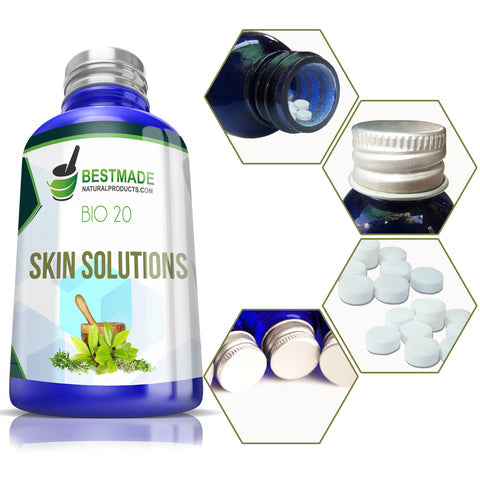

Leave a comment